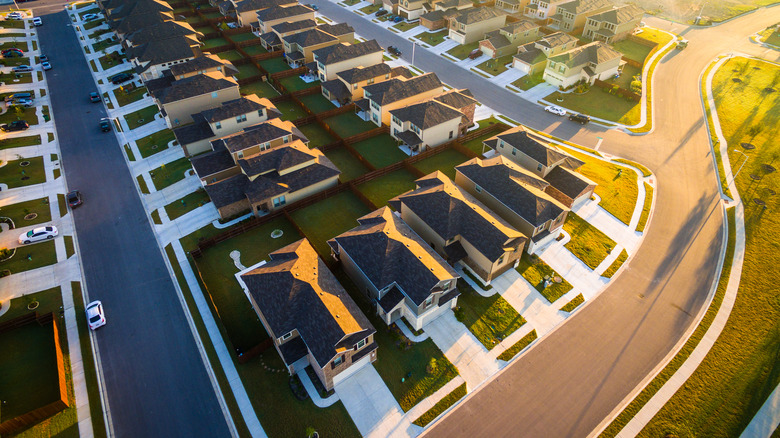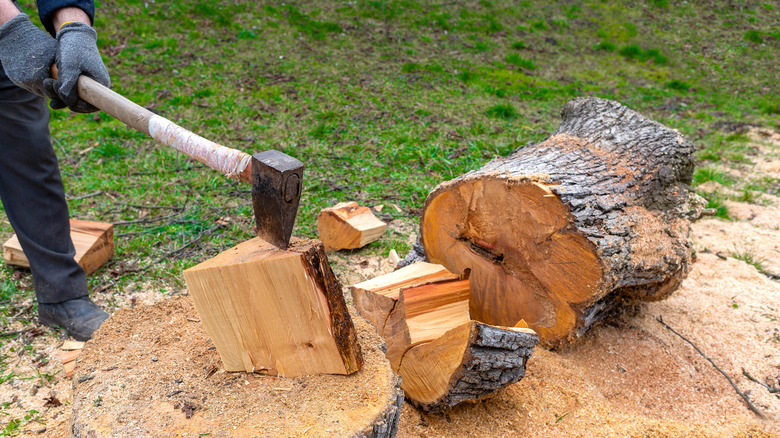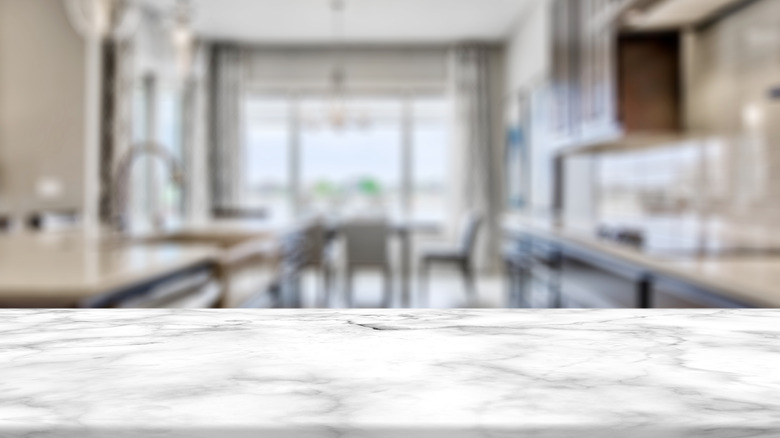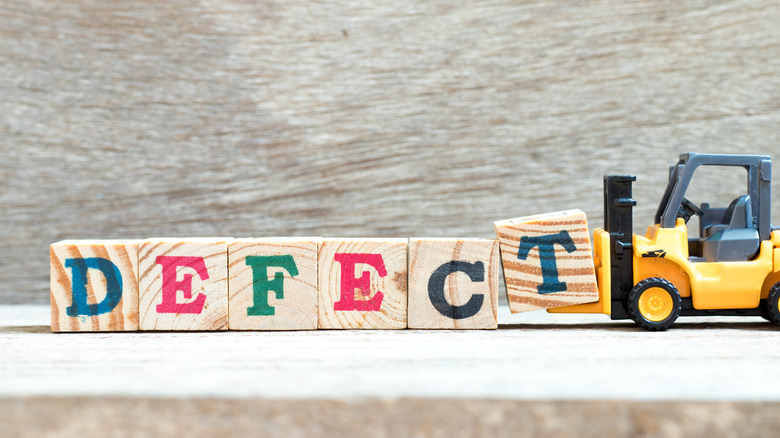The Drawbacks To Buying A New Construction Home
If a brand-new house is at the top of your wish list and you're ready to splurge, now might be the time to dream big for you and your family. But sometimes, that home sweet home we imagine isn't based on reality. A new-construction house can have headaches, just like an existing home in an established neighborhood. The key is recognizing the drawbacks because new isn't always worth the drain on finances.
Buying a house is still one of the most expensive purchases made in a lifetime. It's certainly not surprising that Forbes puts purchasing a home right up there with the most money-grubbing expenses of a lifetime. To put it another way, a home purchase is among the top five things people spend over 50% of their lifetime earnings on. For that reason and more, buying a new-construction home is not a decision to be made in the dark.
Greater strain on the wallet
Buyers expect to pay for a home and the property it sits on, but new construction takes it to a whole other level that may break some budgets. Do you wonder who pays for driveways, sewer lines, sidewalks, and utilities? The answer is typically the buyer, and these expensive items contribute to making a new construction home roughly 20% costlier, says Bob Vila.
With an existing home that passes a reliable home inspection, you know the costs involved for the most part. But with new construction, there are so many unknowns, including the cost of wood, concrete, and other materials. This uncertainty can cause financial angst for both buyers and builders. "Lumber is so crazy, I'm not selling a house until it's built," Mickeal Soliman, CEO of New Jersey General Contractors and Builders, told Forbes. "When you start telling people that the cost of their build is going to rise because lumber prices are rising, they start asking questions and getting worried. It's not worth it. Now, we just build new homes and the price is the price when it's done."
The waiting game
Want to get settled in a new home ASAP, perhaps before the holidays or the start of a new school year? Many people don't want to live in limbo. Once they have decided to move, they want to pack it up and go. But a new build is not a speedy route, and here's why. Rocky economic times can mean backlogs in building supplies like lumber and stone. Contractors are often at the mercy of the market, with limited quantities to go around. Even when the material is available, it must be trucked to the job site, and labor shortages can backlog deliveries. In addition, no home can sell without town permits and inspections, and often building departments are overwhelmed by demand.
The consequences go far beyond a test of patience into wrecking the budget. The buyer may have already sold their last home, intending to close on their new build simultaneously. With delays, the only recourse may be temporary housing like extended hotel stays, a short-term apartment lease, or living with Aunt Edna for a while. Yet another expense is renting a storage unit for who knows how long. Setbacks can jeopardize mortgage rates too. According to Millionacres, mortgage rates fluctuate, so you're not grandfathered into the rate you received at the beginning of your home buying process. If your home build takes too long, you risk losing your original rate or can incur fees.
The bad builder blues
The builder you hire can be the difference between a dream or a nightmare for new construction. Many builders have the experience and skill to get you in that brand-new house with minimum hassle. But some leave tears and anxiety wherever they go. Make the choice an educated one by seeking recommendations from those you trust —a friend, a relative, or a real estate agent. Google the builder's name to rule out a history of complaints and contact the Better Business Bureau.
Don't be shy about visiting past projects associated with a builder and chatting with neighbors there. They will be able to tell you what working with this contractor might be like. Just be aware that buyers often don't get to pick their builder in a subdivision. In these planned developments, it is usually one or two set builders who tackle all the work. If you don't like the builder, you'll have to look elsewhere. Nolo stresses that choosing a builder with a stellar reputation is more important than buying a house for its aesthetics. A lousy builder will slap together a cheaply made house and stop all communication with you to keep their pay.
Cookie-cutter options
When a builder is designing an entire subdivision, they often limit the choices for common elements like flooring, countertops, cabinetry, and even paint. Moving.com explains that builders will usually only give you a choice between two paint colors, so if you want something more creative or visionary, you will have to change that when you move in. No, the builder is not trying to stifle creativity (or deny you that long-craved billiards room,) but too many choices can be maddening for inexperienced buyers. Confusion reigns with a sea of options, and the last thing a contractor needs is project delays over paint color. For those who want the freedom to customize, however, these limited options may be a spoiler.
Buyers can work around this to an extent, but Forbes recommends caution. Each time a buyer adds to the builder's basic design options, they're stretching their budget a little more. It's tough to talk down a builder on the cost of customizing. However, sometimes builders won't even consider upgrades on certain aspects of the home design. Consequently, the buyer might be forced to live with the builder's tastes in countertops and carpets or invest in renovation once the project is done, which can be a big financial ouch.
No trees for shade
If you're moving to the country to be close to trees and nature, you won't get that feeling with a new-construction house. It's not unusual for shade trees to topple to clear the way for a new subdivision, trading that rustic look for desolation. Mighty oaks take years to create the tree-lined streets that bestow character on an older neighborhood — a waiting game that steers some from a new build.
Even when contractors try to curtail the chainsaw, construction could still take a toll both during and after a building project, says Arbor Day Foundation. Builders understand that mature trees attract potential home buyers, but sometimes more trees die than intended during the build. That's because it takes experience to avoid compromising a tree's underground network of roots during construction work. Even changing the terrain around a tree can spell disaster.
The loss of trees means a loss of wildlife, which creates a ripple effect that goes far beyond a lack of shade on a sizzling summer's day. As greenways disappear, deer, black bears, and other wildlife are no longer connected to their lifeline: the forests. So if you, as a buyer, looked forward to both trees and nature, you may want to house hunt in an established neighborhood.
Paying for upgrades
Like a new car that gets significantly more costly with each add-on feature, a new-construction home can be upgraded right out of your price range. The financial danger is real for those who go way beyond the home's base price trying to create their dream home. The cost of upgrades depends on what you choose and which builder you hire. Can't do without quartzite counters and a marble backsplash? Expect to pay top dollar for such amenities. Sometimes just mirroring the featured home in an advertisement means incorporating lots of pricey upgrades, says Realty Times. Even a garage door opener can mean shelling out extra because, you guessed it, it's another upgrade.
A simple way to think about it is that anytime you're making a change, you're spending more money. When it comes to the kitchen, you're especially treading on a minefield of potentially exorbitant upgrades. Features like top appliances and the marble mentioned earlier can easily wipe out your wallet. Some other budget-busters might be wood floors, an extra bedroom, bathroom upgrades, and raised ceilings, says Realty Times.
Rules, rules, and more rules
Do you think a new home might be the perfect place for a koi pond? That might not be the case with a new subdivision, so don't start digging without approval. Often these developments are linked to homeowners' associations (HOAs), made up of fellow residents, who may limit your idea of the good life with rules on everything from rock walls to clotheslines. HOAs might be aspiring to maintain aesthetics so that property values stay high, but everyone's idea of Eutopia varies. If you're a free spirit, an HOA-controlled development might be too confining.
HOAs also typically charge fees, which is another cost to contemplate with a new-construction home. According to Investopedia, the monthly maintenance charge is standard for all owners and may vary greatly depending on the area. These fees may cover lawn care, garbage removal, and other services the homeowner won't have to dole out for. They also ensure the upkeep of common areas like a pool, park, or clubhouse.
But wait, don't put the calculator away yet: There may also be special one-time assessments. When a community expense like new sidewalks must get tackled, these assessments make it happen. Costs can quickly wreck your budget if not considered upfront. And don't forget to ask about upcoming assessments, Melanie Narducci, an Arizona real estate agent, told Curbed. This is yet another part of the financial picture of what it costs to live in an HOA community.
Cost overruns and change orders
If unexpected costs are associated with new construction, the buyer is typically the one paying the difference. Anytime there is a building project, a variety of unknowns can impact finances. So many things are beyond the builders' control, including the price of lumber, construction supplies, and delivery delays, which can take an economic toll. When this happens, the builder will likely try to pass this on to the buyer.
"Cost overruns happen quite frequently through unforeseen costs or changes made during construction," Chuck Meier, senior vice president of Sunrise Banks, told Bankrate. Read the fine print because it's not uncommon for builders to add a clause that lets them direct increased material costs back to the buyer. In that case, it may be perfectly legal for a builder to recoup his costs with a higher purchase price.
Change orders are another tool that a builder may use to hold onto their profit when faced with unforeseen circumstances. However, the builder doesn't have carte blanche to pass along these costs. According to Millionacres, both the builder and buyer have to agree to change the contract before continuing with change-order work.
Limited bargaining power
Homebuyers have long been accustomed to negotiating with sellers to get the best price for a house. Offers and counteroffers have been a hallmark of real-estate transactions. Maybe you're used to flexing your bargaining skills or have a dynamo of a real estate agent you trust to whittle down a home's price. Then you might be disappointed that there's limited or no room to bargain over new-home construction. If you simply must have some bargaining power, a newly-built home may not be the best option.
"The developer or builder is usually the seller of new construction, and they never want to decrease the list price," Utah real-estate agent Jen Horner told Bankrate. In a subdivision, a reduced list price can affect more than the home a buyer is seeking to haggle over. In other words, reduced profits for the builder can extend beyond just the house under consideration.
Higher loan costs and taxes
Keeping your eyes wide open to the expenses associated with new construction includes knowing in advance about the cost of loans and taxes. If you're paying cash for your new build, then go ahead and skip this part. For everyone else, building a custom home is likely to mean a construction loan. Designed to cover the expense of custom construction, including materials and labor, these loans usually run 12 to 18 months, says The Mortgage Reports. Expect around 1% more than a typical mortgage rate. Down payments also run 20% to 30%, according to NerdWallet.
Once the construction loan is no longer needed, the buyer is likely to need a mortgage still and should lock in a rate when it's favorable. Construction delays may jeopardize an attractive rate otherwise. Property taxes also tend to run higher for new construction than for existing homes of similar size. As taxes go up more often than down, the additional money spent can be significant over time. And according to Millionacres, buyers can't always go by the tax estimates they first receive on a new-construction home. The taxes can increase by thousands of dollars once a more detailed assessment is made.
Poor quality materials
Not only can a builder be a hassle to work with, but they can ruin a home with shortcuts and lower-quality materials. When homes are in demand, builders might stretch things thin to make deadlines. True, building inspections guard somewhat against safety issues, but they haven't eliminated the horror stories from buyers stuck with a construction headache. Millionacres explains that when buying new construction, you will typically get "builder grade quality," which means the materials and features are more economical than quality.
Home inspections are indispensable in a booming market where builders might take shortcuts, but buyers should also be aware of potential problems and ask questions. "Material has gone sky-high," Nick Gromicko, founder of International Association of Certified Home Inspectors, told Bankrate. The result? Today, a poorly cut piece of lumber may not be swapped out for a fresh piece. "They're more likely to patch." If not done correctly, this could lead to trouble. And that's just one example of deteriorating standards.
The right home warranty can provide some protection against a problem no buyer wants to face. For example, major structural defects are typically covered for 10 years, says Nolo. You should also get this warranty from an independent insurance company rather than purchasing it through the builder for best results.
No quiet time during neighborhood construction
When packing essentials for your move, earbuds are not likely to make the top of your list. But they can be indispensable. Buyers who are early birds in a new subdivision often must deal with daybreak drilling and other noise, not to mention blocked sidewalks and truck traffic as the rest of the development takes shape. No doubt living in a work zone of a neighborhood, even if just for a short time, clashes with the idyllic vision expected of a new home setting. But it may not be a short time. Bob Vila says new neighborhood construction can create a racket for months or even years. Best to pack your patience as well.
The truth is that construction depends on some of the noisiest equipment out there — think jackhammers and pile drivers. A homeowners' right to enjoy a measure of peace is protected to some degree under city ordinances, which limit work to certain daytime hours and decibel levels, says U.S. News & World Report. The problem is that some necessary construction equipment cries out for earbuds no matter what. These high-decibel noisemakers typically require a city permit, but will not be banned altogether. The bottom line is the construction must go on. Who wants to live in just a shell of a community after all?
Smaller lot sizes may spoil plans for backyard fun
For some, the space available for backyard living is almost as important as the house itself. Parents want ample space for kids to play ball, climb a play structure or maybe jump on a trampoline. They don't want neighbors close enough to watch their every move. For buyers who can't wait to barbecue for friends and family poolside every weekend, the smaller lot sizes associated with many subdivisions may prove disappointing. According to Bob Vila, lot sizes in new developments are typically dwarfed by those in older established neighborhoods, although there are exceptions.
Of course, if you are custom building a home on your own land, you're likely to get a lot that suits your lifestyle. But lot sizes in subdivisions are shrinking, putting neighbors closer to each other than ever before with less space between homes. According to Realtor Magazine, median lot sizes reached the smallest level on record in recent years. The size tends to vary by region. The median lot size in New England is considered the largest in the nation, while dense areas like California just don't have the vacant land to be that generous.













